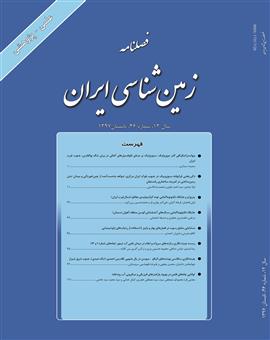دگرریختی فرانهاده سنوزوییک در جنوب بلوک ایران مرکزی: شواهد بهدستآمده از چینخوردگی و میدان تنش زمینساختی در کمربند ساختاری رفسنجان
محورهای موضوعی :لیلا عبادی 1 , سید احمد علوی 2 , محمدرضا قاسمی 3
1 - دانشگاه شهید بهشتی
2 - دانشگاه شهید بهشتی
3 - سازمان زمینشناسی و اکتشافات معدنی کشور
کلید واژه: رفسنجان تنش دیرینه چرخش بلوکی فرانهادگی چین چند گامه,
چکیده مقاله :
جنوب بلوک ایران مرکزی تحت تاثیر چندین گامه دگرریختی شدید در زمان سنوزوییک قرار گرفته است. این پژوهش یک مورد از دگرریختی تداخلی چینهای فرانهاده در جنوب ایران مرکزی ارائه مینماید و با تحلیل تنش دیرینه حاصل از دادههای لغزش گسلی، توالی دگرریختی و رژیمهای زمینساختی در طی کوتاهشدگی پوسته را بازسازی مینماید. دادههای مستخرج از چینهای فرانهاده نشان میدهد،گستره جنوب رفسنجان دو رژیم زمینساختی ترافشاری را تجربه نموده که موقعیت عمود به محور چینها داشتهاند و سبب فرانهادگی چینها با روندWNW-ESEبرروی چینها با روند NE-SW شدهاند. از سوی دیگر تحلیل ساختاری و مطالعه دادههای لغزش گسلی در گستره دو میدان تنش همزمان با چینخوردگی را در سنوزوییک نشان میدهد. اولین گامه زمینساختی تا اوایل میوسن، رژِیم ترافشاری با روندNW میباشد که منجر به توسعه چینهای با روند NEو ایجاد کوتاهشدگی عمود به گستره شده است. این رویداد زمینساختی احتمالاً به چرخش پادساعتگرد بلوک ایران مرکزی وابسته است. رویداد زمینساختی ثانویه در اواخر میوسن تا عهد حاضر، رژیم ترافشاری NNE-SSW میباشد که انقباض چینهای با روند WNW-ESE را ایجاد نموده و سبب فرانهادگی چینها در گستره شده است. از نظر ژئودینامیکی، گامه زمینساختی اخیر احتمالاً در ارتباط با همگرایی صفحه عربی به سمت صفحه اوراسیا میباشد.
The South Central Iran Block has experienced polyphase intensive deformation in the Cenozoic time. Large-scale superposed folds in South Rafsanjan document the Cenozoic tectonic events within the South Central Iran Block. In this study, a case study of this deformation inferred from regional-scale Rafsanjan superposed folds in the south of Central Iran is presented to reconstruct the deformation sequence and tectonic regime during crustal shortening. These data indicate that the superposed folds, dominated by a two-stage tectonic transpression regime which experienced two phases of superposed folding, leading to the orthogonal superposition of WNW–ESE-trending folds onto NE–SW trending folds. Structural analyses and fault kinematic analyses in the Rafsanjan Structural Belt indicate a two-stage syn-folding paleo-stress field during the Cenozoic. The early phase of tectonism is characterized by late Miocene NW-SE transpression, which led to the development of NE-trending fold structures and causing the occurrence of an orogeny perpendicular shortening. This tectonic event was most likely associated with progressive anticlockwise rotation of the Central Iran Block. Subsequent tectonic event from Late Miocene until Quaternary contributed to a phase of contraction that overprinted the early NNE–SSW shortening in the interior parts of the studied area and generated a large-scale NE-convex fold belt and the typical large-scale superposed folds within the South of Central Iran Block. In terms of geodynamics, the later tectonism is likely to have been related to the NE-directed convergence between the Arabian and the Eurasian Plates.
